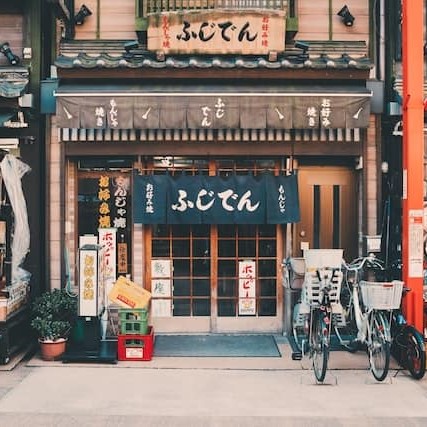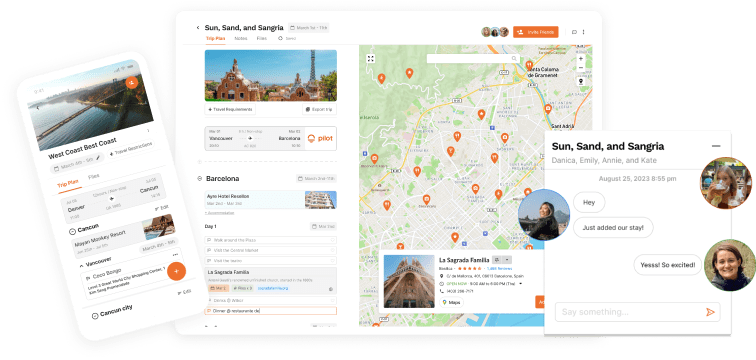Table of Contents
Autumn has been my favorite season since I was a small child. Or at least that used to be the case before I had my first taste of spring in Japan.
While cherry blossoms can be seen in many places all over the world, there are very few things that can beat watching the land of the rising sun turn pink seemingly overnight.
If you’re here, you’re probably just starting to figure out whether planning a trip to Japan around the cherry blossom festivals is worth it.
The term "hanami" in Japanese translates into "flower viewing." It could technically be used for any other flower, such as plum or wisteria. That said, it's most commonly associated with cherry blossoms.
So let’s find out whether attending a hanami is for you! I’ve been living in Japan sporadically for over 11 years, so I’m going to share some of the most interesting facts I’ve learned about this beautiful and special tradition.
Not only will you get a bit of a history lesson, but you’ll also find out some important tips and tricks on how to attend the cherry blossom festival successfully.
It’s coming up fast, so let’s not waste anymore time!

Traditional Stories Behind the Hanami
While Emperor Saga held the very first cherry blossom viewing party in 812, the history of hanami stretches further back. Before these festivals were a thing, cherry blossoms, or "sakura" as they are called in Japanese, have long been revered as a representation of a particular goddess.
You can find descriptions of a beautiful mythical goddess, a guardian deity of Mount Fuji, in the Kojiki, the oldest historical record in Japan dating back to the 700s.
Here's what the Japanese tradition says...
"Sa" was written with the sign meaning "god" and was referencing the god of rice paddies. "Kura" on the other hand, was represented by the sign for a particular pedestal used to honor a god with offerings of sake and food.
According to the mythology at the time, the blooming cherry blossoms were a sign that the god had come down from the mountains and that it was time to plant the rice.
How Cherry Blossom Viewing Came to Be
The practice of hanami has its roots in the Nara Period, which was from 710-794. But what many don't know is that the inspiration for the flower-viewing tradition actually comes from China.
Before Japanese cherry blossom viewing was a thing, the Chinese had a tradition of viewing plum blossoms. The Japanese picked up on this tradition when they sent envoys to China to study its culture and technologies.
This practice ended at the start of the Heian Period, 794-1185, leading Japan to start fostering its own culture and setting the premise for hanami.
The first hanami, complete with food, music, and poetry, was held by Emperor Saga and became a regular event from 813. In the beginning, this type of event was, however, held exclusively for the aristocratic class.
Famous samurai and shogun Hideyoshi Toyotomi held 2 huge hanami gatherings 4 years apart in Yoshino, Nara Prefecture, and Kyoto's Daigo Temple, respectively. These two parties are what planted the seeds of the big hanami parties that the Japanese enjoy today.
However, commoners would have to wait until 1603 before joining in on the festivities. Two mindful shoguns, Iemitsu Tokugawa and Yoshimune Tokugawa, would continue to plant cherry trees in what later became present-day Tokyo intending to share the sakura with the commoners.
A popular theory is that Yoshimune planted sakura along the Sumida River to relieve flooding in the area. The idea is that the sight of the beautiful blossoms brought herds of people to the river and their footsteps in turn helped compact the ground and harden it enough to prevent it from being washed away.
According to the theory, this also explains why you often find cherry trees alongside rivers in Japan.

Why Do the Japanese Celebrate Cherry Blossom Festivals?
In preparation for this article, I asked some Japanese friends for their perspectives on hanami.
Perhaps the most commonly known explanation for the Japanese's love of cherry blossoms is that they remind you of how short and fleeting life is, so you should enjoy it to the fullest.
Unlike many other types of blossoms, cherry blossoms only bloom for around 1-2 weeks before the pedals get swept away by the spring breeze.
And while this explanation certainly rings true for many Japanese, there are also plenty of other reasons why the festival is celebrated.
One of my friends told me that many Japanese use it as an excuse to get together with friends, family, or co-workers and get drunk. Another said many Japanese companies use it to throw a welcome party for recruits.
While Japanese schools don't do hanami together with their students, cherry trees are often planted near the school gates. These trees, in turn, bloom around the same time as entrance ceremonies are held for the students. For this reason, cherry blossoms and entrance ceremonies are often viewed as two parts of the same set in Japanese society.
When Do You Celebrate the Cherry Blossom Festival?
As I mentioned earlier, cherry trees are only in bloom for a short time, and when it occurs depends on many different factors.
While most of Japan doesn't see cherry blossoms until March or April, the cherry trees in Okinawa bloom as early as January. On the other hand, Hokkaido often has to wait until late April or May.
What many people don't know, however, is that there are certain types of cherry blossoms that bloom in autumn and winter. I was completely unaware of this until I went for a stroll in rural Nagoya one December day and discovered a big pink cloud peeking out from behind the red and yellow leaves of the other trees.
Types such as jyugatsu-zakura, literally "October cherry" in Japanese, or fuyu-zakura, "winter cherry," bloom in spring and then again between September and December.
If you are traveling in Tokyo during this time, you can find some of these trees in both Shinjuku Gyoen and Ueno Park. The winter cherries are, however, not tracked and observed in the same way as the cherries in spring, so it's hard to know when they will bloom.
But suppose you do decide to stop by in spring and want to try and time your visit to when the sakura are in bloom. In that case, you can find the cherry blossom forecast on the Japan Meteorological Corporation's website.

Where to Celebrate the Cherry Blossom Festival
Cherry blossom viewing is observed all over Japan. You won't have problems finding somewhere to enjoy the blossoms as long as you arrive when the trees bloom.
If you want to sit down for a proper hanami, your best bet is to find a nearby park. However, note that different parks have different rules, and in some places, you aren't allowed to sit down under the trees for your hanami.
If you're keen to walk around and explore, I recommend you seek out castles, temples, and shrines in the region you are visiting. These places are beautiful on their own, but it's taken to an entirely new level when surrounded by all these pink clouds of cherry blossoms.
Do remember that it tends to get extra crowded around these areas at this time of the year!
If you need help determining where to go, you can always book a guide. If you'd instead go by yourself, you can find information about some of the most popular cherry blossom festivals in Japan Cheapo's event calendar.
How to Celebrate the Cherry Blossom Festival
The Japanese way to do hanami is to make a picnic out of it. Some might barbecue, while others settle for bringing some easy snacks and drinks to share.
When I think of hanami snacks, I think of hanami-dango. This is a tricolored mochi or rice cake on a spit and no hanami is complete without one. However, there are also many other kinds of snacks or foods, both sweet and savory, that are big hits at any hanami.
Whatever you plan on sinking your teeth into, it's recommended that you prepare it in advance before arriving at the park or location in question.
While you may find a nearby convenience store in most places, chances are that it will be very crowded and even sold out on the day. This is particularly true in popular spots such as Yoyogi park in Tokyo.

If you plan to travel with your friends to have a hanami picnic, you must reserve your spot as quickly as possible on the day you plan to go. Especially the more popular locations—they tend to fill up quickly once hanami season kicks off.
There is only one way to secure your spot: to get to the location as early as possible in the morning and reserve a space with a sheet. While it's not always necessary, it's also always best if someone stays with said sheet until the others show up.
Reserving your group’s hanami spot isn't always the most fun job, especially if this same person has to wait all day until everyone gets off work. Unfortunately, there's no other way to do it!
It's for this very reason that this particular task is often given to the newest recruits at Japanese companies when it comes to company hanamis.
If you want to try something different, you can often partake in many events when doing hanami. For example, why not rent a kimono for the day? Many companies arrange special hanami cruises under the beautiful blossoms. These cruises can be found all over Japan.
Remember Your Hanami Etiquette!
Like most things in Japan, there are some etiquette rules you should adhere to when you frolic among the cherry blossoms. Failure to follow these rules will, at best, get you sour looks from the people around you, but at worst can end with you getting a fine or even arrested.
Don't Touch the Cherry Trees or the Blossoms
I know it's tempting. However, cherry trees are easily susceptible to damage, which can lead to them getting various diseases or attracting pests.
Don't pull or break the branches, don't climb the trees, and don't stand on their roots. Neither should you pick the flowers off the tree for any reason. Just stick to admiring the tree, like the people around you.
Take Your Shoes Off
If you're interested in Japan, you're likely already familiar with their rule of not wearing shoes indoors. This rule also applies to the blanket or sheet you'll be sitting on in the park if you decide to go the hanami picnic route.
While this might not matter to you, this is a rule that you should always keep in mind when you're with friends, family, or your Japanese work colleagues. Leave your shoes at the edge of the blanket or sheet.
Clean Up After Yourself
Garbage cans are notoriously difficult to find in Japan. While many of the more prominent and popular parks for hanami will usually put out particular bins for you to throw away your trash, this isn't always the case.
Either way, you must clean up after yourself when you leave. If no bins are available, you're expected to take your trash and dispose of it at home.
Don't Get Too Drunk
Yes, I did say that many Japanese people view hanami as an excuse to get drunk with their friends. But this doesn't mean that you should allow yourself to get to the point where you are being a nuisance to the people around you.
Aside from annoying others, this could result in paying a hefty fine in some locations. Be sure to bring plenty of food and snacks to enjoy with your alcohol.
Research the Rules of the Hanami Location in Question
Whether a park or a temple, each location sets its own rules for what's allowed and what isn't. Some parks, like Shinjuku Gyoen in Tokyo, don't allow you to barbecue or bring alcohol. Other parks don't allow you to sit down for a picnic at all.
Enjoy the Cherry Blossom Festival From Outside Japan
You can still participate in a cherry blossom festival, even if you cannot attend in Japan. Many countries outside of Japan arrange their own flower viewing, often hosted by each country's embassy or Japanese society.
Sweden arranges their celebration every spring, where you can enjoy Japanese foods and performances from various Japanese organizations in Stockholm's Kungsträdgården. While they rarely manage to time their event to when the park's many cherry blossoms are actually in bloom, it's still a fun celebration to enjoy.
A National Cherry Blossom Festival is also hosted in Washington, DC, every year. Unlike in Sweden, the celebrations last for several days, and it's the biggest celebration of Japanese culture in the United States. Here you can enjoy various cultural performances and exhibitions and browse different vendors selling traditional and contemporary Japanese goods.
While the cherry blossom festival is perhaps most closely associated with Japan, you can also enjoy the cherry blossoms in many other countries in Asia, such as South Korea and Taiwan.
Don't feel like going out? Don't worry! The Japanese Weather Channel has a number of VR videos on their Youtube channel for you to enjoy without having to leave the comfort of your home.

Plan to See the Blossoms With Pilot!
Spring is a beautiful time to travel to Japan. You should definitely plan your trip for when the cherry blossoms are in bloom.
But if you decide to visit during this time, book everything for your trip as soon as possible. Cherry blossom season isn't just popular with tourists and the Japanese.
This means that prices on both flights and accommodation tend to go up, and you also run the risk of things getting fully booked if you wait for too long. Don't run into stressful problems when planning! Organize your trip in advance and ensure you're putting everything in one place. A trip planner, perhaps?










![Paris Neighborhoods Guide [2024]: Areas to Visit & Avoid!](https://assets-global.website-files.com/63d1baf79ce0eb802868785b/65b947376eff1a3e72606d03_Paris%20Neighborhoods%20Guide.jpg)
![8 Best Things to do in Tokyo, Japan you can't miss! [2024]](https://assets-global.website-files.com/63d1baf79ce0eb802868785b/63d1baf89ce0eb286368815a_9876543.jpeg)

![Japan's Cherry Blossom Season: When to Visit [2024]](https://assets-global.website-files.com/63d1baf79ce0eb802868785b/63fd2ce9c18c7d20ed079e79_japan_during_cherry_blossom_season.jpg)



